New perk! Get after it with local recommendations just for you. Discover nearby events, routes out your door, and hidden gems when you sign up for the Local Running Drop.
An exploration of the fastest-known-time (FKT) concept
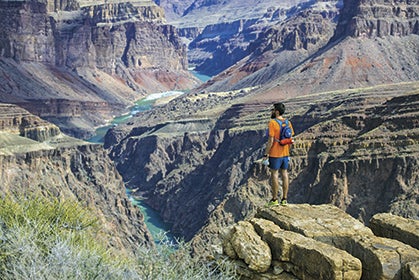
Rob Krar soaks in the enormity of the Grand Canyon. Photo by Ken Etzel.
This article originally appeared in our March 2014 issue.
Say the phrase “fastest known time” or its abbreviation, “FKT,” at a trail-runner gathering and watch the magic happen. Eyes sparkle, hands flutter and conversations settle on some wild FKT notion. Case in point, not long ago at a small dinner with friends, 23-year-old, Boulder, Colorado-based, pro mountain runner Dakota Jones waxed eloquent about an FKT outing on a route through the La Sal Mountains above Moab, Utah, he’d like to attempt. He raved about the route’s trail-less nature, the height of its mountains, rugged talus slopes for which the La Sals are known and just how fast a talented human being could move over the terrain.
A fastest known time is the fastest reported time for an effort on a specific trail or route. This roughly corresponds to a race’s course record, except that FKTs are usually solo or near-solo efforts. Longer FKTs are sub-divided into unsupported, self-supported and supported categories, delineating the degree of outside help someone receives, as well as male versus female FKTs. If you’re familiar with Strava, the workout-tracking tool, then you know its FKT equivalent, the “King/Queen of the Mountain” award, which is given to the Strava user who has the fastest time on a particular route.
While the origin of the phrase “fastest known time” is unclear, the climbing and trail-running communities have been using it for a few decades. Peter Bakwin, 51, of Boulder, Colorado, is the keeper of the Fastest Known Time ProBoards, forums that document trail-running FKTs. If you’ve ever Googled a trail-running speed record, you’ve ended up in those forums.
Bakwin’s interest in moving quickly through wild landscapes clicked in 1999, when he and his friend, Buzz Burrell, now 62, an accomplished mountain runner also of Boulder, attempted an FKT on the Colorado Trail, a 486-mile route from Durango to near Denver. Mid-route, Bakwin dropped with an injury but Burrell lowered the then-record from about 17 days to 11-and-a-half days. The following summer, the pair set a new John Muir Trail FKT. In addition to these and other personal FKT endeavors, Bakwin began keeping an FKT database.
“I like moving fast. I like to hear about others moving fast, and am inspired by their stories,” says Bakwin. “I track known records, but people are also running fast backcountry routes that we don’t know about.” Bakwin says that he accepts FKT reports on an honor system, but recommends using photos, videos, independent verifiers and GPS devices to validate an FKT. “You put in a huge effort and trashed your body for the next six months,” says Bakwin on the ProBoards. “You want people to believe what you say you did, right?”
In this article, we delve deep into the FKT phenomenon through the stories of seven significant, recent FKTs. We also discuss ethics—how to be good stewards as we recreate in wild places—and some more adventure-run routes everyone can enjoy.
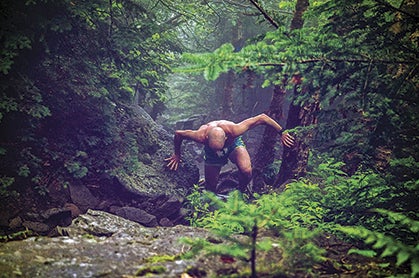
Ben Nephew in typical New England terrain. Photo by Joe Azze
For presidents and crazy folk: Ben Nephew and the Presidential Traverse
The Presidential Range of New Hampshire is home to perhaps the most consistently technical terrain in New England. It’s also host to some of the windiest and foulest weather in the country—“the stuff that’ll blow you off the mountain,” says 38-year-old Ben Nephew, who holds the Presidential Traverse FKT.
The Presidential Traverse runs north-to-south for about 18.5 miles over the range’s spine, passing over eight mountains named after U.S. presidents and delivering roughly 8,500 feet of climbing. Nephew, of Mansfield, Massachusetts, set the current FKT on September 7, 2013, at 4 hours 34 minutes 36 seconds.
There’s a reason for that 15-minute-per-mile pace, explains Nephew, a biomedical-research scientist: “The route begins with a 4,000-foot climb, and the northern section is ridiculously technical. Picture loose, sharp rocks the size of an ottoman to a small couch. Some have moss on the edges and are very slippery.”
Former FKT holder Ryan Welts, a 33-year-old small-business owner from Northwood, New Hampshire, describes the traverse’s second half, “If you make it to Mount Washington in under three hours and with any gas in the tank, it’s time to open it up across the southern peaks, which are more runnable but still demand the use of your hands plenty of times.”
“You have to decide what level of risk is acceptable,” says Nephew. “In going fast, you’re going to fall at some point. The faster you go, the harder you’ll go down. It would be easy to have a life-threatening accident.”
When Nephew set the record in September, he improved upon a record set just a couple weeks prior by Jan Welford at 4 hours 35 minutes 29 seconds. The Presidentials are covered with a big blanket of snow now, but will soon see summer action among a cadre of local guys vying for the FKT. Says Nephew, “Anyone who dips that record under 4 hours 30 minutes is either going to have a massively elevated level of fitness or is willing to take bigger risks.”
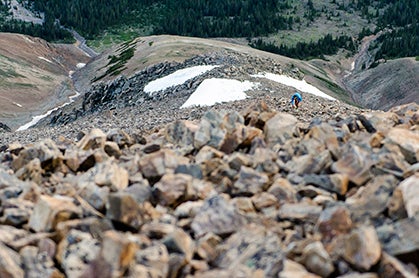
Nolan’s 14 in Colorado’s Sawatch Range rebuffed all suitors in 2013. Will a new FKT go down in 2014? Photo by Matt Trappe.
An Almost Unattainable Line: Nolan’s 14
Nolan’s 14 is a point-to-point route of about 100 miles that traverses 14 14ers in Colorado’s Sawatch Mountains. Athletes who try Nolan’s 14 can choose any route they wish, as long as they summit the designated 14ers. Nolan’s 14 hopefuls use a combination of singletrack, unkempt mining trails, dirt roads and cross-country travel. Let’s be accurate—most of the trek is cross country. The route’s high altitude wrecks bodies and attracts severe weather. And, finally, the creators of the Nolan’s 14 line, ultrarunner Fred Vance and mountaineer Jim Nolan, established a 60-hour time limit to reach the last summit.
The route is so absurd that few men or women have the cajones to give it a shot. In fact, only seven people—all men—have completed the line in under 60 hours. The fastest guy was John Robinson, in 2002, in 54 hours 57 minutes. (Just in case you need more evidence that Robinson is baller, the FKT was his second Nolan’s 14 finish.)
Eric Lee, a 32-year-old research scientist from Boulder, Colorado, is the most recent of the seven Nolan’s 14 finishers. Says Lee of his 2012 battle, “While spending two sleepless nights on the trail was difficult, the relentless thin air of high altitude took the biggest toll. The most memorable part of the adventure was how all three sunrises brought the mountains to life in different ways.”
Last summer, according to the Nolan’s 14 website, six people made a total of eight attempts. Colorado Springs, Colorado’s Julian Smith came closest to success. He finished 12 14ers before reaching the 60-hour time limit, where he then called his effort a day (well, uh, two-and-a-half days).
The 47-year-old engineer says, “I’m a mid-packer, not the fastest out there.” But Smith is an ultrarunner who has twice completed the Hardrock 100, often considered the hardest 100-miler in the U.S., and has a history in rock, ice and mountain climbing. “Nolan’s is twice as hard as Hardrock,” says Smith. “Remember, Hardrock is 13 climbs up high-mountain passes with Handies Peak, a 14er, thrown in. Nolan’s is 14 summits over 14,000 feet. Not only do you go up higher more times, but the terrain of Nolan’s is much harder, too. Less trails and more exposed places where you could fall and really hurt yourself.”
Smith plans to again join the small, almost-insane corps of men and women who will brave the route in the summer of 2014. “I have a ridiculously bad habit of picking up challenges without giving them much thought.”
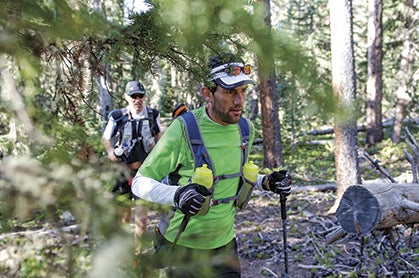
Scott Jaime grinding it out during his FKT on the nearly 500-mile Colorado Trail. Photo by Matt Trappe
Limitless: Scot Jaime and the Colorado Trail
In 2009, Scott Jaime ran and hiked the 486-mile Colorado Trail (CT). The 44-year-old who works in pharmaceutical sales and lives outside of Denver was plagued by shin splints and a logistical learning curve as steep as sections of the CT. Jaime finished in about 11-and-a-half days but knew he could go faster. It was only a matter of time until training and stars would align for him to give the CT supported FKT another go.
The time was right in August 2013—in 8 days 7 hours 40 minutes 17 seconds, Jaime successfully reset the supported FKT, which was previously held by Paul Pomeroy at 8 days 12 hours 14 minutes. Jaime traveled an average of 58 miles a day and slept for a few hours each night in an RV. He used the assistance of a crew, which included his wife, Nicole Jaime, his father-in-law, Rick Robinson, his parents, Alverna and Julian Jaime, and photographer/videographer Matt Trappe. A passel of ultrarunning friends alternated as pacers.
Jaime says the most volatile moment came on day five. Just before dark, he arrived at a crew point that was 43 miles in but still 17 miles from the day’s end point. There, his father-in-law pulled the plug on the day—he worried that Jaime’s traveling so long into the night would compromise the attempt. Jaime worried that stopping early would put him behind record pace.
“The shortened day five was the first time Scott had to dig into the cushion he had built into his schedule,” explains Denver-based Trappe, 32. “He was still beyond half way and well ahead of record pace. He hadn’t been sleeping well so he was due for a shortened day and some extended sleep. I knew the extra rest would keep him on track.”
But Jaime’s ability to go on would have to come from within, not from others’ confidence. “I went into the RV, lay down and promised myself I would continue,” remembers Jaime. “I thought about my years at the Hardrock 100. Every year I struggle, and am on the edge of DNFing at some point. But when the race ends, I’ve put down a good time.” At 3:45 a.m. the next morning, Jaime pressed on, catching up each day on those lost miles and setting a new record.
“This was about finding my personal limit,” says Jaime. “No one knows their limits unless they seek them out.”
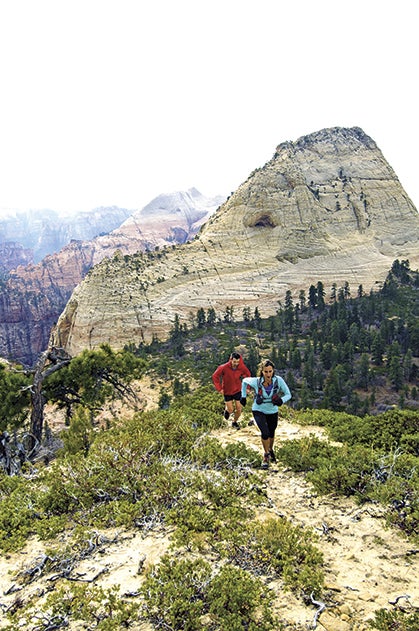
Former Zion Traverse FKT holder Krissy Moehl and Jared Campbell on a run in Zion National Park. Photo by Fred Marmsater
Simple Escape: Bethany Lewis and the Zion Traverse
Bethany Lewis holds the women’s FKTs for both the Grand Canyon Rim-to-Rim-to-Rim and the Zion Traverse, an almost-50-mile, point-to-point route across Zion National Park. Lewis set the women’s Zion Traverse record on April 21, 2013, at 8 hours 32 minutes, bettering Krissy Moehl’s previous record of 9 hours 9 minutes.
Mike Foote, the 30-year-old co-men’s FKT holder for the Zion Traverse (with Justin Yates) who works as a race director in Missoula, Montana, says, “The traverse is dynamic and inspiring with steep climbs, technical descents, deep sand, hot temperatures and, in places, herds of tourists.”
Why does Lewis, a 35-year-old academic dermatologist from Salt Lake City, Utah, run FKT efforts? “I like to run fast with my husband, Ben. It’s easier to get a babysitter for my daughter if we’re going for an FKT. People get behind that kind of effort.” She laughs and continues, “I don’t look at numbers or read about FKTs on the Internet. I rarely wear a GPS.” Lewis runs by how she feels and lets her fitness—and husband—take care of the records. “Ben keeps tabs on the numbers and tells me what records he thinks I can break. It’s really that simple.”
For the Zion Traverse, she started on the route’s east side at 7 a.m. sharp. “Because I always accidentally shut off watches,” she says she needed a simple starting time of day as a backup. “I ran the first 11 miles or so, from the East Rim Trailhead to Zion Canyon alone.” There she met Ben, and together they climbed out of Zion Canyon and onto the western half of the route. The hardest part for her was a stretch of several sandy miles in Hop Valley, which they hit with about 10 miles to go. “Oh, how the sand swallows your momentum!” she says. “I’m sure some people run the last hill, but I had to hike. My legs were done.”
“My record is soft,” says the modest Lewis. “There are so many people doing far more amazing things.”
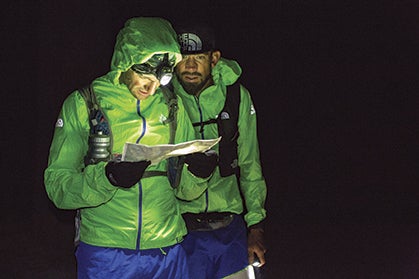
Mike Wolfe and Hal Koerner get their bearings on the JMT. Photo by Tom Robertson
Of Muir and Men: Mike Wolfe, Hal Koerner and the John Muir Trail
California’s 223-mile-long John Muir Trail (JMT) stretches from Whitney Portal, the traditional Mount Whitney trailhead, to the Happy Isles trailhead in Yosemite National Park. It traverses the high Sierra Nevada, a white-granite wonderland that’s largely above treeline and, thus, almost always inundated with sunlight. The JMT is named after environmentalist and High Sierra lover John Muir, who called the Sierra Nevada the “Range of Light” for this interplay of rocks and sun.
“Oh, that high-altitude sun was brutal—it burned my brain!” says Mike Wolfe. In August of 2013, Wolfe, a 36-year-old attorney from Missoula, Montana, and Hal Koerner, 38, who owns Rogue Valley Runners, a running store in Ashland, Oregon, reset the supported JMT FKT in 3 days 12 hours 41 minutes. Sue Johnston had set the previous overall supported record in 2007 at 3 days 20 hours (Johnston still holds the women’s supported record).
Wolfe and Koerner’s record is unique because not only did they work with a support crew but they also worked together. Says Koerner, “We were out there for all that time, but we didn’t actually talk much. You can’t actually talk much. We both had this understanding of the effort we were putting out, and having someone there to recognize it made working together worthwhile.”
One thing that FKT efforts have in common with races is that the record isn’t in the bag until the effort is over. Wolfe and Koerner, due to being behind schedule, ran into trouble at mile 130 when they missed their crew person. They debated taking a long detour off route to restock at a store or forging onto their next crew point low on calories.
“We both sat on a log, took deep breaths and decided, ‘We’re not letting this stop us,’” says Wolfe. “We had a little food to tide us over and we just hammered. I bonked so hard I was hallucinating. We just put our heads down and did it.”
Sue Johnston, 48, the previous supported JMT FKT holder, says these types of problems are the real hindrance to even-faster JMT FKTs. “If someone with speed, endurance and a crew can get through the effort with no real issues, they should be able to go under three days.”
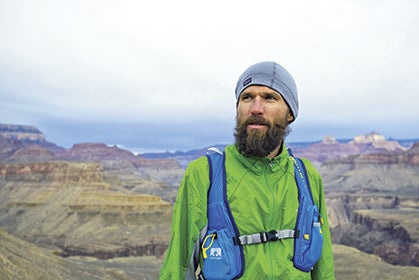
Last year, Krar crushed the Grand Canyon’s Rim-to-Rim-to-Rim FKT by over 30 minutes, but says he’ll never beat that time. Photo by Ken Etzel
Canyon Krarnage: Rob Krar and the Grand Canyon Rim-to-Rim-to-Rim
In the predawn of May 10, 2013, on the precipice of the Grand Canyon, Flagstaff, Arizona’s Rob Krar hit his GPS’s start button and plunged down the South Kaibab Trail toward the canyon’s bottom, up to the North Rim via the North Kaibab Trail and back the way he came. Forty-two miles, about 10,000 feet of descent and ascent and a double crossing of a big hole in the ground later, Krar returned and shut off his GPS.
The numbers on the watch? Six hours 21 minutes 47 seconds. Krar became the FKT holder of the Grand Canyon Rim-to-Rim-to-Rim (R2R2R) route, massively improving upon Dakota Jones’s previous record of 6 hours 53 minutes 38 seconds.
So stout is Krar’s FKT that trail runners mostly guffaw about it, and so does Krar. When he arrived to the Grand Canyon’s North Rim at halfway, he used a video camera for documentation. Krar panned the camera around the trailhead and then focused it on his watch. The video footage captures his reaction— a slew of expletives.
“I didn’t look at my watch until then,” says Krar. “I’ve run the canyon enough times that I know what my effort should be. But I was not expecting to see my effort translate into that number.” That North Rim time was just 11 minutes slower than his FKT for the one-way R2R of 2 hours 51 minutes 28 seconds.
Says the 37-year-old pharmacist, “The canyon is a harsh place and I’ve had many bad days in it. But, this time, I was given a magical day.”
In 2011, when Jones broke the then-R2R2R FKT, he wrote in a blog post that he thought the record would go under six hours in the near future. Krar’s effort has gotten the FKT closer to that six-hour barrier. Says Jones, “I’m impressed by Rob’s record. He’s a great example of a fast [track and road] guy taking up ultras and doing very well, so he is a natural to set records like this one. But I think his record will be broken, and soon, too.”
“I would love it if someone broke my record,” says Krar, “but I will not run the Grand Canyon FKT again. I don’t think I could repeat the magic of that day.”
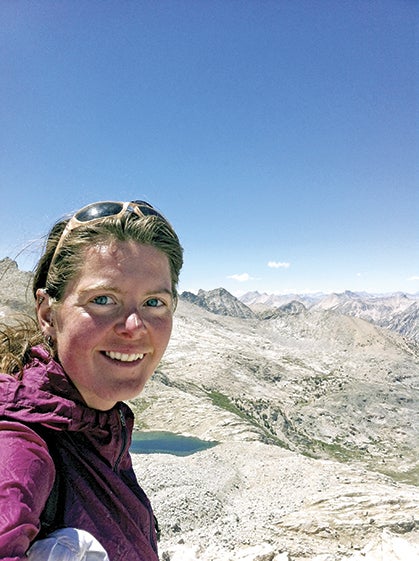
Over 43 miles per day for over 60 days straight! Enough said. Photo by Heather Anderson
She walks far and fast: Heather Anderson and the Pacific Crest Trail
Sixty days 17 hours 12 minutes. That’s the time it took Heather Anderson last summer to walk from Mexico to Canada on the 2,663-mile Pacific Crest Trail (PCT) in self-supported style, carrying a backpack containing food and camping equipment and resupplying at grocery stores and with boxes of food she’d mailed to post offices near the trail.
In doing so, Anderson, who goes by the trail name “Anish,” set the PCT’s self-supported FKT—for both women and men. Scott Williamson set the previous self-supported record in 2011 at 64 days 11 hours 19 minutes. (Williamson still holds the men’s self-supported record.)
We know, we know. This is Trail Runner magazine, not Trail Hiker magazine. But if you let the enormity of Anderson’s effort sink in and acknowledge that hiking is an integral part of our sport, you’ll understand why we’re writing about her. Sleep on the ground, in a tent, with ultralight gear. Get up and start walking until you’ve traveled more than 43 miles, then lapse to sleep again. Repeat for 59 more days. This FKT is as extreme as it gets.
“This might be the greatest feat of lightweight backpacking ever,” says Peter Bakwin. “First, the logistics are intimidating. Then there’s the difficulty of keeping up a hard effort for two months. Finally, Anish committed to a very pure thru-hiker style, eschewing planned external support and even walking to off-route resupply points instead of thumbing rides.”
Even Anderson had a hard time coping with the scope of her effort. “Thinking about the big picture would sometimes make me cry,” says the 32-year-old race director and health-food-store cashier who lives near Bellingham, Washington. “I broke it into days and the days into segments of trail connecting road crossings or resupply spots, like in a 100-miler where you run from aid station to aid station.”
Prior to this record, Anderson had become a Triple Crown hiker, which means she’d backpacked the entirety of the Appalachian, Pacific Crest and Continental Divide trails, America’s premier long-distance trails. Anderson thinks she’s made for long-distance pedestrian travel, “I never feel that bad when I’m on a long-distance hiking trip. I usually finish less beat up than my male counterparts.”
Why did Anderson make her FKT attempt? “I did this to become a stronger woman.”
Responsible Running:
Let’s face it. Adventure runs and FKTs are damn sexy and a lot of us are enjoying them.
For example, one day in the spring of 2013, Grand Canyon National Park officials counted 900 hikers, runners and backpackers in the canyon bottom. That’s per Bill Wright, 52, the park’s Chief Ranger, “The sense from rangers who have worked the inner canyon for 15-plus years is that we are experiencing huge visitation increases. That’s what prompted the head count. We needed to get a feel for how many people were actually using the infrastructure.
“Not everyone has the park’s best interest in mind. Littered gel wrappers, organized running groups operating illegally and complaints from hikers about rude runners—I deal with these problems. I believe that the people who care about the Grand Canyon don’t cause problems, but the people who see the canyon as another tick for their checklist can. In the future, we will likely have to manage for day-use visitors in the canyon’s bottom.”
Kurt Achtenhagen, 42, Director of Finance and Operations for Boulder, Colorado’s Leave No Trace Center For Outdoor Ethics (LNT), says, “Leave No Trace is very pro recreation. We want people outdoors.” LNT simultaneously advocates for the responsible use of the outdoors. “Even just one person has an impact, so we believe everyone should minimize their impact,” says Achtenhagen. “There are times of the day you should never try for an FKT here in Boulder because there are too many other users on the trails.” Achtenhagen, who likes to move fast and light on his own backcountry outings, adds, “Put up a record in a responsible manner—to the resources, wildlife, and other people. Make it a record you’ll want to stand behind.”
Impact-reducing guidelines for your FKT attempt or adventure run:
- Stay off muddy trails. If you encounter mud, run through it, not around it off trail.
- Pack out trash and practice Leave No Trace principles for camping and bathroom stops.
- Respect trail closures.
- Follow dog leash laws and pick up after your animal.
- Respect other trail users and adhere to local trail-user right-of-way regulations/recommendations. Choose the quietest time of day for a fast attempt on a popular trail.
Meghan M. Hicks, based in Moab, Utah, holds the FKT between her front door and refrigerator for an after-run beer.